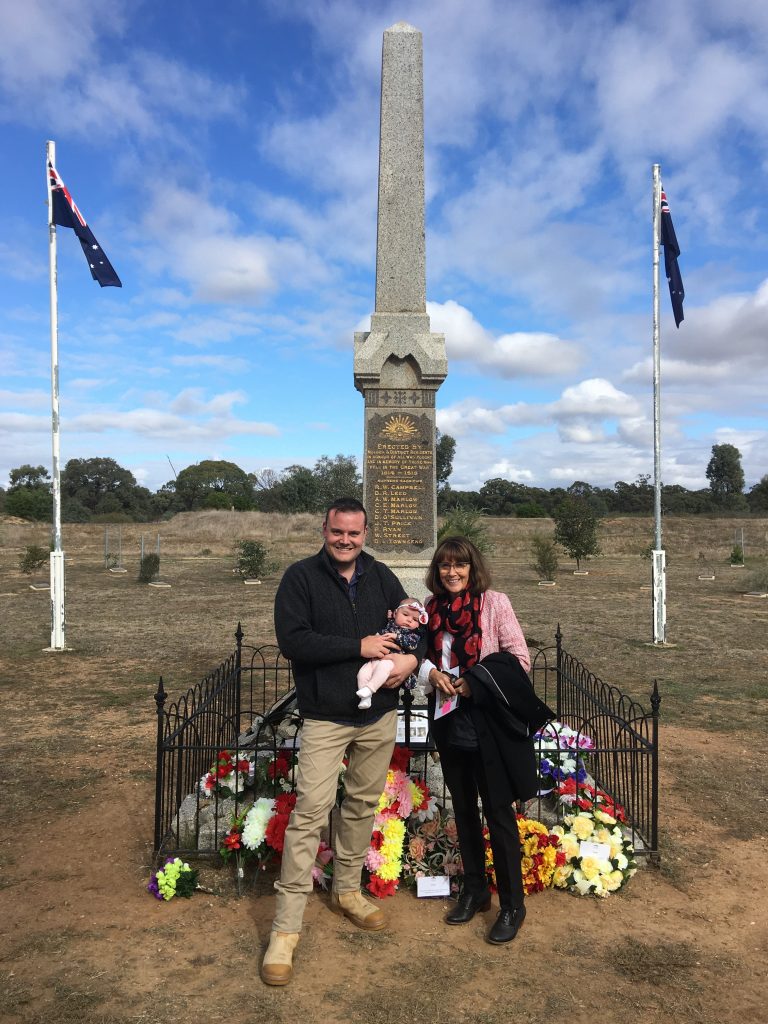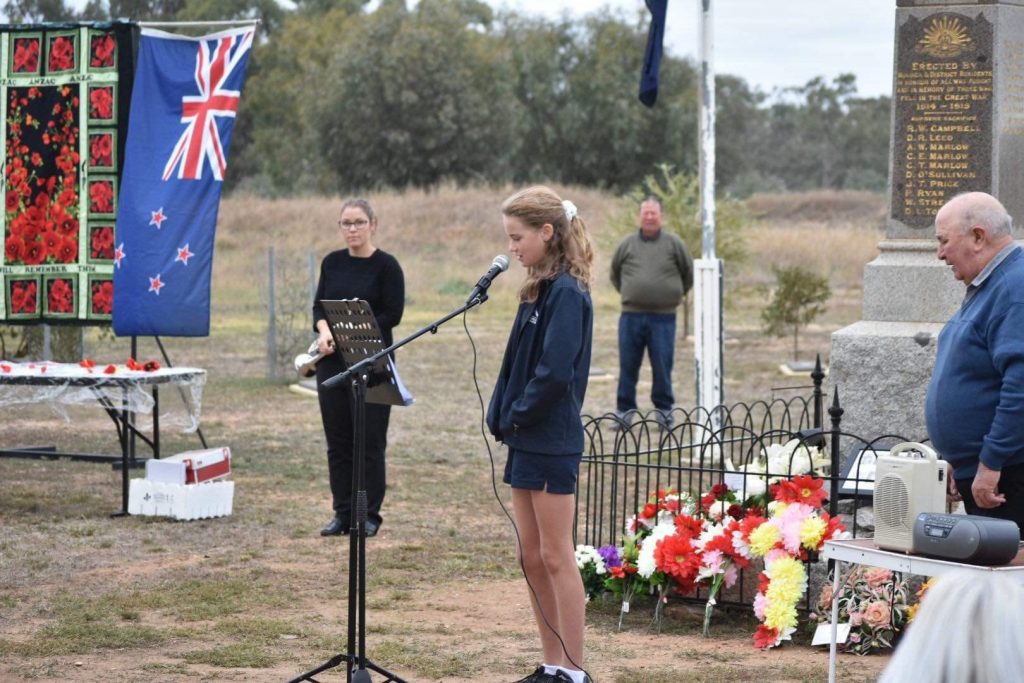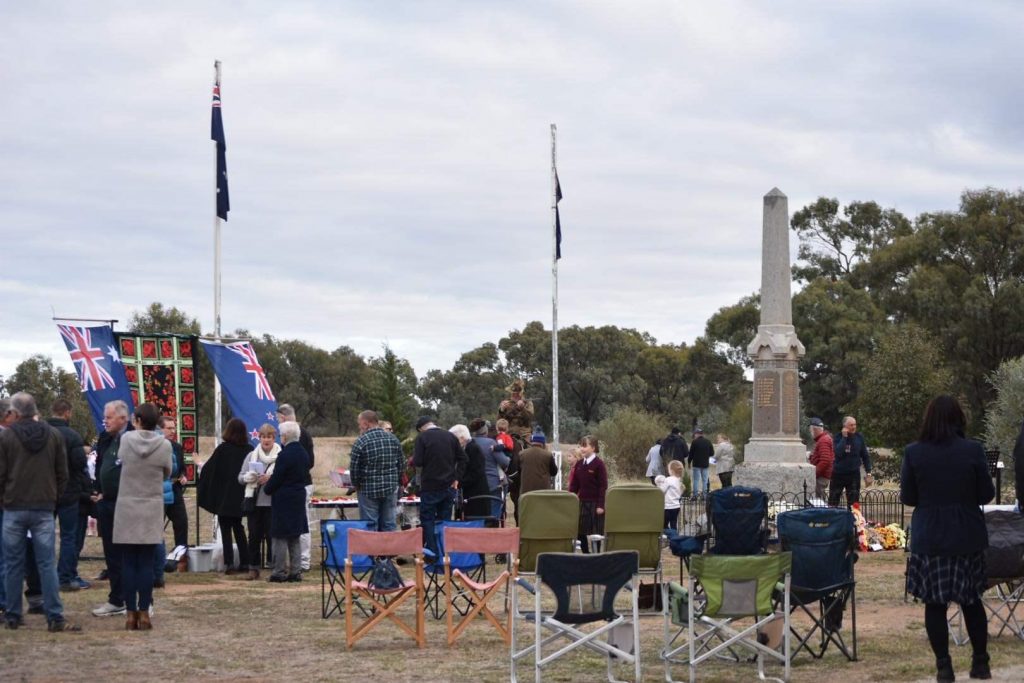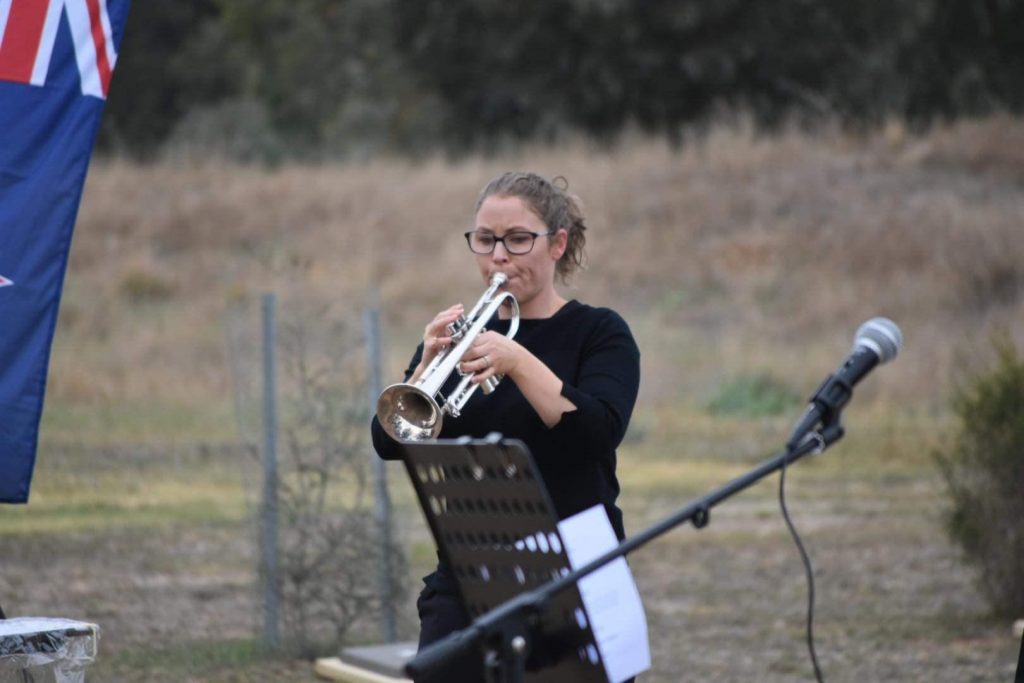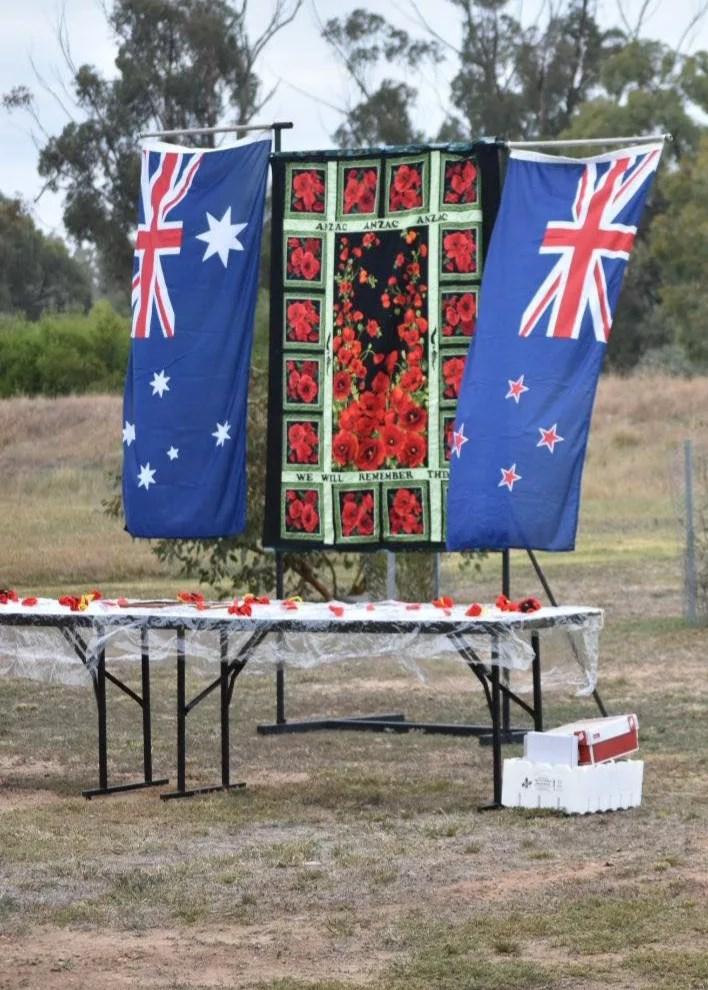
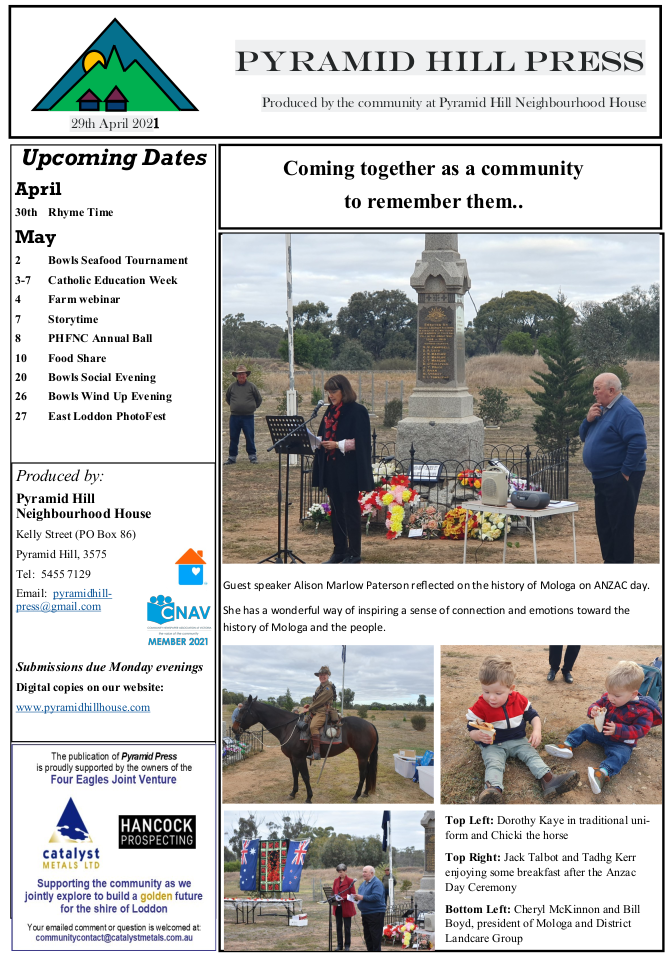 Pyramid Press Article – click here to view
Pyramid Press Article – click here to view
Mologa Anzac Day Address 2021 – Centenary Service
Allison Paterson
I would like to begin by thanking you, the Mologa community, for the honour of providing this address today. It is a very solemn occasion, one with special meaning for both me, and the extended Marlow family. I also want to thank all of those people, both past and present, who fought for the Mologa memorial to remain in its home and who have cared for it over the years. We all owe you a huge debt. This remains a sacred place to all of us, and it should always be just that.
Over a century has now passed since the signing of the Armistice that called an end to World War I, a war in which millions of people suffered and died. It is almost impossible for us today to imagine how it was to live through the years of 1914 to 1918, to face the uncertainty and the fear. Across the world approximately 16 million people lost their lives and another 20 million were wounded, of these 8 million were left with a permanent disability. Of a population of just 4.9 million, 340,000 Australians served overseas in the combined Australian military forces, 313,000 of these were of the volunteer Australian Imperial Force. One in five of the Australians who enlisted were destined to not come home.
The war memorial about which we gather today, reminds us that twenty-two young men were farewelled from the township of Mologa. They boarded the train from the railway siding that existed just beyond us, usually amidst some fanfare and gathering of friends, family and townsfolk. Fourteen of these young men called Mologa home and ten were never to return. They were neighbours, mates, sons, brothers, husbands and fathers. They were family. They left with a sense of duty and some with a sense of adventure. Five of these twenty-two young men who enlisted were the sons of Sarah and Charles Marlow. Three did not make it home: 25-year-old Charlie, 24-year-old George and 19-year-old Albert. A further seven sons are listed on this memorial under the heading Supreme Sacrifice: Will Street, Les Townsend, Jack Price, Ray Leed, Robert Campbell, Pat Ryan and Daniel O’Sullivan. A lost generation of young Mologa men.
Also listed are those Anzacs who, through sheer luck, returned to their families. They were changed men. Some carried disabling physical injuries or painful scars, others suffered neurological damage. For most, they carried unseen psychological wounds which they endured in their darkest moments and in their nightmares – Tom Alford, James Dillon, Charles Fyffe, David Fyffe, Alf Ferris, Tom Gray, Amos Haw, Knowlson Haw, Ewen Johnston, William Leed, Allan Marlow, Percy Marlow, Hugh Martin, Andrew Price, John Ryan, Michael Ryan, Herb Street and Wilsie Townsend.
For families like those of Sarah and Charles Marlow, like the Townsends, the Leeds, the Prices, the Campbells, the Ryans and so many more across the world, no number of patriotic words could ease their pain. As a child, I was told that my Great-grandma had died of a broken heart. I never really understood what that meant, not until I had read the letters of her sons and understood the anguish a parent would feel. Her surviving sons always reassured Sarah and Charles that they had organised for a wooden cross to be made and placed on the last resting place of their brothers. Families at home did not have graves about which they could gather and grieve for their loved ones. Sons were buried or missing on distant shores that for most, they would never have the opportunity to visit.
The need to commemorate was strong, and the war memorial movement spread across the world. Committees were formed to create lasting memorials such as monuments, avenues of honour, memorial halls, honour boards, parks and gardens. Communities wanted to show their respect and gratitude, they wanted to honour the service and sacrifice of the locals who had served their country.
Like so many memorials to those who served in WWI, the funds to erect the Mologa memorial came from the work of community members. As reported in the Pyramid Hill Advertiser, on 6 December 1918, residents of Mologa gathered:
In a corner of a nicely shaded and grassy paddock on Mr Pickles’ farm on Wednesday, a good number of district residents assembled at a picnic arranged for the purpose of raising funds to set up a suitable memorial to soldiers from the locality to recognise the valour of all and to keep in memory those who have fallen in the fight.
Then, as if the suffering from the war was not enough, the deadly Spanish Influenza virus was shortly after detected in Victoria. First reported in March 1918 on the Western Front, it mutated and began to spread across the world. With the war’s end, the slow process of returning service personnel to their countries had begun. They took the virus with them. Across the world it is accepted that at least 50 million people died, some suggest 100 million. In January 1919, Victoria was placed in quarantine. Public meetings were banned, public buildings shut, restrictions were placed on long-distance train travel and the border between NSW and Victoria was closed. This all sounds so familiar to us today.
Up to 40 percent of Australians were infected and 15 000 people died, fortunately one of the lowest mortality rates of any country.
At the conclusion of 1919, the devastating epidemic was declared over.
A few months later, in March, 1920, the following report appeared in the Pyramid Hill Advertiser.
Mologa Soldiers Memorial
The residents of this district have worthily placed on record their estimation of their soldiers by erecting a handsome stone column, which was unveiled on Wednesday 24th, by Mrs C. Marlow, to whom the honour was justly due, as is well known, by the fact that five of her sons volunteered, of whom three are in soldier’s graves … In the unveiling ceremony Lieut. A. Marlow escorted his mother on to the platform and the large assemblage stood bareheaded as the cords were cut and the covering Union Jack removed from the pedestal.
Regardless of a pandemic, the local community had built their memorial.
Last year 24 March, 2020 marked 100 years since the memorial was unveiled by my great-grandmother Sarah and my grandfather Allan. Sadly, we were unable to gather together as a community to commemorate this important day in the life of Mologa and its surrounds. Instead, and with some sense of disbelief, the world experienced an upheaval, not one brought by war, but that of another deadly pandemic, one that caused fear, impacted our freedom and changed our way of life.
But, like our ancestors, we will overcome the changes that COVID-19 has brought us. The uncertainty will eventually pass, and we will recover. Australia is a country that is strong and prosperous. By and large, we work together and we help each other. This is not by chance. The ideals and characteristics of the people who have come before us, became the foundation of our nation’s identity, its pride and its success. We have much for which to thank our ancestors.
The story of Mologa and its young men typifies the experience of families across the globe during World War One. Sons went to war; daughters went to nurse them. They sacrificed their lives for King and Country with a sense of duty and as young, obedient soldiers. Yet Australians were different, they were volunteers who had little time for spit and polish. They were renowned for their irreverent sense of humour and showed little tolerance for the class structures of the British military. Yet they respected, admired and followed the best of their leaders. They believed in a fair go; they were resourceful and tough; they were courageous and fiercely loyal; they were prepared to give their lives for their mates. Such was the spirit of the Anzacs.
War Memorials today continue to remind us of that Anzac Spirit, of those who served in World War I and those who have served since in the defence of our way of life. But local war memorials are more than that. They became the closest to a grave most families would ever have about which they could mourn their loved ones. Local war memorials represented the last resting place of men buried on distant and out-of-reach shores. Local war memorials are also a reminder of a resilient generation and a reflection of a supportive community. Let’s continue to emulate both the Anzac and community spirit of one hundred years before. The people rallied, they supported each other, they persevered and their monument was built.
That the Mologa War Memorial still stands in this location, and that we can continue to gather about it on our days of commemoration, reflects an enduring community spirit, one that remains despite the decline of the thriving town that once existed on the land upon which we stand today. Thank you to the Mologa and District Landcare Group whose work in the preservation of the memorial is appreciated by the descendants of those whose names are etched in gold. It is a lasting reminder to us all of great service, courage, perseverance, resilience and sacrifice. Thank you to all of you who continue to gather here on Anzac Day and Remembrance Day to keep the memory of these young men alive.
We are the custodians of the Anzac Spirit and it is our duty to pass on that responsibility to future generations. It is the duty of all of us, today and always, to never forget.
Allison Paterson
